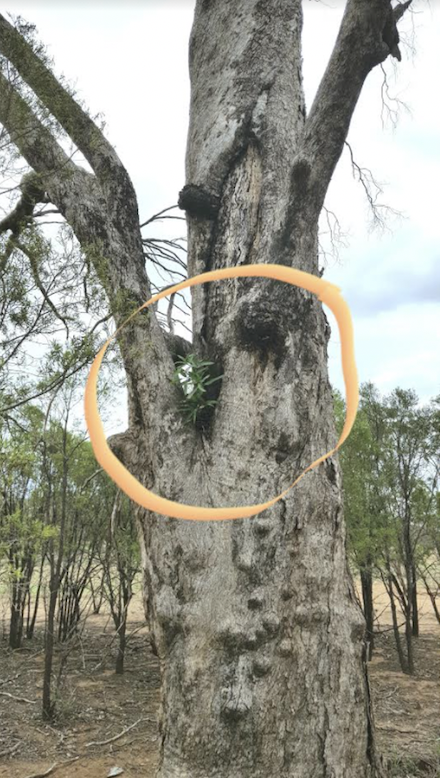Glenda Browne summarises recent queries about trees sent to our office email. Our group of experts responds.
Religious trees?
We received an interesting question about a photo of a spotted gum that had appeared on a religious site, and was claimed to show a person bending down and praying. The pattern on part of the trunk looked like an arm. The questioner wondered whether it was possible that humans may have interfered with the tree to give this effect or whether it was most likely to be natural.
Many spotted gums (Corymbia maculata) have distorted trunk shapes, especially when growing on sandstone outcrops. It is possible that the tree was bent over by something heavy in its early years and has managed to grow under and then above the obstacle. It could also be that there was some natural deformity that was enhanced by human action.
It was suggested that the ‘arm’ pattern could have been caused by damage to the tree. Because spotted gums have an annual shedding process where the outermost layer of bark changes colour (dies) and sheds off, it would be hard to maintain a human-manipulated pattern long-term. Fires would also alter the pattern.
While it was possible that someone had manipulated the tree to achieve a desired purpose, the general feeling was that nature is varied, and often produces patterns that can be considered meaningful.
Trees in trees
Another question about nature versus nurture was related to culturally-modified trees. The question was whether a tree growing in another tree was likely to have been sown by a person or naturally ‘planted’. In the picture below, the whitewood (Atalaya hemiglauca) has germinated about five metres up a dead scartree.

Consultation within and beyond our experts group suggested that trees in trees are not uncommon and that planting could well have been natural, with the seed placed by birds, possums or bats.
One way of checking would be to estimate the age of the trees.
On the other hand, Kamilaroi contacts of the questioner believe that the plants were culturally sown and symbolise tribal unions. The three hosts are the bimble box, black box and coolabah and the most common guests are peach bush, wilga and currant bush. If you see any trees in trees, Jane Pye would like to hear from you at janepye6@gmail.com. See more at https://scartrees.com.au/galleries/trees-in-trees/.
Long stem planting for native trees
We were asked: Do you think long stem planting (deep planting) is good for most native trees?
Long stem planting was found to be successful with long lanky plants that most of us would agree had been left in the tubes in the nursery for too long. This system of planting was first practised with river oaks, casuarinas and the bottlebrushes that occur in alluvial soil along streams, and has also been used with rainforest species in a rainforest environment.
The questioner had included a list of plants, and it was thought that the two melaleucas on the list could be planted long stem, but that Acacia leptostachya which grows in inland Queensland might not be well-suited for the technique.
Method
- If you are experiencing a drought or frost, wait until the seasonal growing conditions are improved. The plants should be grown in large forestry tubes (90 x 90 x 250 mm) and grouped together so that the taller plants become sun seekers. Use a fertiliser with less than 2% P (phosphorus).
- Trim off all leaves except the top 15 cm. Dig hole to the depth of the length of plant minus about 20 cm. Fill hole with a bucket of water and allow to drain. Remove forestry tube and back fill the hole. It is best to put the soil back where it was – put the dirt from the bottom of the hole back in the bottom of the hole and work your way up. Do not import soil or put bagged soil (from the nursery) into the hole.
- Water again. Usually no further watering is required, but if very dry, water deeply and then only so often – e.g. plant distressed, very dry and hot windy conditions, etc.
- Protect plants from your furry friends as they will have a field day.
A ‘Gardening Australia’ factsheet mentions that Bill Hicks of the Australian Plants Society developed this method for native plants – https://www.abc.net.au/gardening/factsheets/long-stem-planting/9430210. And there is lots more information in the long stem planting guide from the APS Central Coast Group at https://austplants.com.au/sys/website/?pageId=18177.
Thanks to Mark Abell, John Aitken, Rod Bray, Ralph Cartwright, Rhonda Daniels, Alix Goodwin, Graeme Ingall, Heather Miles, John Nevin, Jonathan Palmer, Jane Pye, Merle Thompson, Dick Turner, Jason Wilson.
